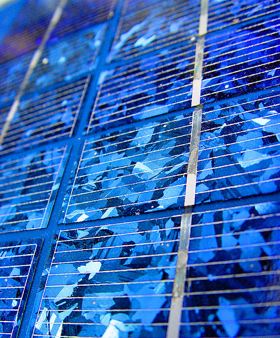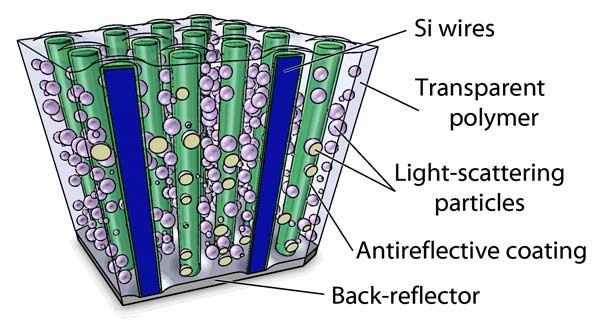New Light-trapping Material Boosts Solar Cell Efficiency
Image credit www.devicedaily.com
Here’s how solar cells work at the most basic level: photons (units of light) hit the surface of the cells and the light energy is quickly absorbed by the semiconductor material. The incoming energy knocks electrons loose from the silicon, and when that happens it’s as close to spring break in Fort Lauderdale as it gets at the atomic level. To keep all the electrons from spending the night sobering up in the local jail and having to make teary calls home their parents, two metal contacts (one at the top and one at the bottom of each cell) create an electric field that forces all the crazy sunburned drunken electrons to line up and form a current that allows us to put them to good use (Source: HowStuffWorks).
It’s not as easy as you might think to free electrons from their cozy little orbits, and today’s best solar cells are not as efficient as one might hope: they convert only “15 to 20 percent of the energy in sunlight into electricity” (Bourzac). We’ve been using way too much silicon to generate not enough electricity for much too much money for far too long. But that could change because a new photovoltaic material has been developed that performs just as well as current solar cells yet uses only one percent of the material to do it!
Image credit M. Kelzenberg
Researchers at Caltech led by professor of applied physics and materials science Harry Atwater have developed a “flexible array of light-absorbing silicon microwires and light-reflecting metal nanoparticles embedded in a polymer” (Bourzac). The idea is that the new material traps incoming photons of light and keeps them bouncing around dislodging electrons for longer periods of time – generating more electricity from less material. Highly reflective alumina nanoparticles are mixed with a rubbery polymer, forming a coating which is applied to arrays of anti-reflective silicon microwires “grown” from gas on the surface of a reusable template. “Once the polymer sets, the entire thing can be peeled off like a sticker. Over 90 percent of the resulting material is composed of the cheap polymer, and the template can be used again and again … The material can absorb 85 percent of the sunlight that hits it, and 95 percent of the photons in this light will generate an electron” (Bourzac).
Image Credit M. Kelzenberg
Using less silicon and decreasing the complexity of the manufacturing process could mean that it will take less capital to build solar cell components and that we will be able to build them more quickly.
WU XING:
This is a fire material because of the light-trapping.
Cited:
Bourzac, Katherine. “Material Traps Light on the Cheap.” Technology Review 02/26/10. Accessed 03/01/10. URL.



















I am not going to be original this time, so all I am going to say that your blog rocks, sad that I don’t have suck a writing skills
Leave a Wordpress Comment: